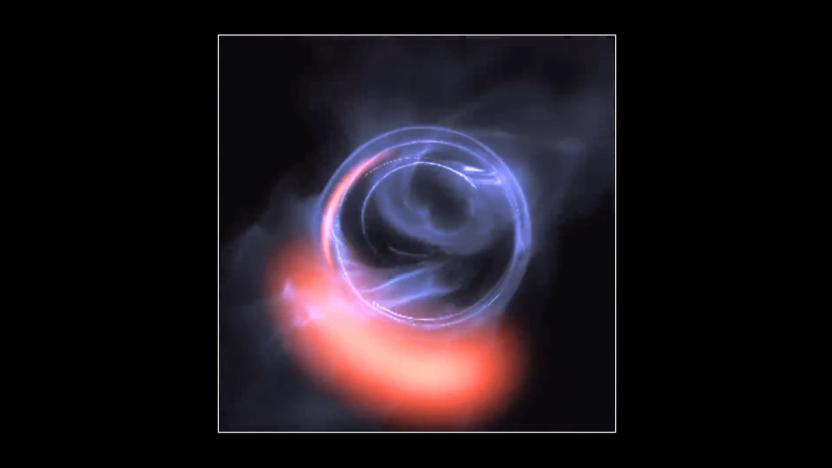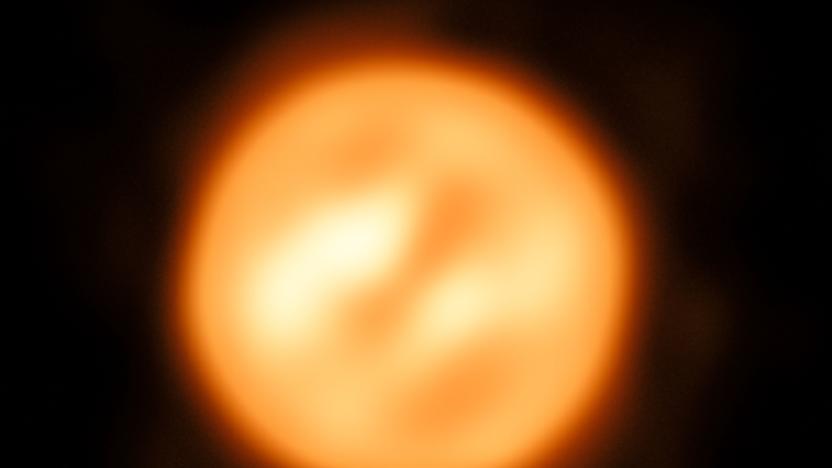EuropeanSouthernObservatory
Latest

Scientists find evidence of a black hole at our galaxy’s center
Researchers have long suspected that a supermassive black hole lies in the center of our galaxy, and now they have strong evidence to support that suspicion. Using the Very Large Telescope -- an array of four individual telescopes stationed in the Atacama Desert in Chile -- scientists have been observing Sagittarius A* (pronounced Sagittarius A-star), an object in the center of the Milky Way galaxy thought to be a supermassive black hole. During their work, the research team observed three bright flares orbiting around Sagittarius A*, which completed 150-million-mile circuits in just 45 minutes. That's about 30 percent the speed of light.

Astronomers capture best image yet of a star other than the sun
See that photo above? It might look a lot hazier than the HD photos you're used to, but it's the best and most detail image of a star other than our own sun that we've captured thus far. A team of astronomers led by Keiichi Ohnaka have used ESO's Very Large Telescope Interferometer in Chile to map Antares, one of the largest known stars and the brightest in the Scorpius constellation. Antares, a red supergiant, is visible to the naked eye as a reddish, twinkling star, but we've never seen it this close before.

ESO will upgrade its Very Large Telescope to hunt for exoplanets
The European Southern Observatory's Very Large Telescope is getting an upgrade. ESO signed an agreement with Breakthrough Initiatives, a program created to search for extraterrestrial intelligence, to modify its infrared instrument called VISIR (VLT Imager and Spectrometer for mid-Infrared). Once it's done, the observatory in the Atacama Desert of northern Chile will easily be able to spot exoplanets in the Alpha Centauri. According to ESO, the astronomers' discovery of a habitable planet in our neighboring star system late last year "adds even further impetus to this search."

Researchers discover new exoplanet orbiting triple suns
In the constellation Centaurus, some 340 light-years from Earth, a newly discovered Jovian exoplanet has just been spotted in what Space.com is calling "a highly exotic celestial arrangement." The planet HD 131399Ab orbits three stars in a dizzying cosmic dance, and for about half of its 550-year trip around the star system, all three would appear visible in the planet's sky.

Astronomers find three planets in Gliese 667C's habitable zone
Astronomers have a good day when they detect one planet inside a star system's habitable zone. A mostly European team of researchers must be giddy, then, as it just found three of those ideally located planets around Gliese 667C. The group has combined existing observations from the ESO's Very Large Telescope with new HARPS telescope data to spot the trio of super-Earths, all of which could theoretically support liquid water. As long as the discovery holds up, it may have a big impact on exoplanetary research: it shows both that three super-Earths can exist in one system and that more than one survivable planet can orbit a low-mass star. We can only do so much with the findings when Gliese 667C is 22 light-years away, but it's good to learn that space could be more human-friendly than we once thought.

Infrared telescope can pick out the atmosphere on distant planets, smell what the aliens are smelling
Astronomers in Chile using the European Southern Observatory's Very Large Telescope are now able to analyze the atmosphere on faraway planet Tau Bootis b. Using CRIRES, a supercooled infrared spectrograph bolted to the 'scope, the team was able to judge the size of the exoplanet -- and for the first time, take a reading of the atmosphere while not in transit. Historically, the only time researchers have been able to conduct atmospheric analysis is during the transit of its nearby star, which imprints the qualities of the atmosphere onto the light. The team found that Tau Bootis b is around six times the size of Jupiter, but its air is so thick with Carbon Monoxide that we'll have to look elsewhere to plan that expedition to the stars.

VLT Survey Telescope snaps out-of-this-world photos with 268-megapixel camera
The European Southern Observatory (ESO) has just released the first batch of shots taken by its VLT Survey Telescope (VST), and, given the results, we'd say the thing's got a bright future in photography. Not to be mistaken for its cousin, the VLT (very large telescope), the VST sports a 268-megapixel camera, known as the OmegaCAM, and a field of view "twice as broad as the full moon." The images released by the ESO feature the Omega Nebula (located in the Sagittarius constellation) and Omega Centauri in stellar detail. Annie Lebovitz, eat your heart out -- the rest of you hop on past the break for another shot by this up and coming shutterbug.




